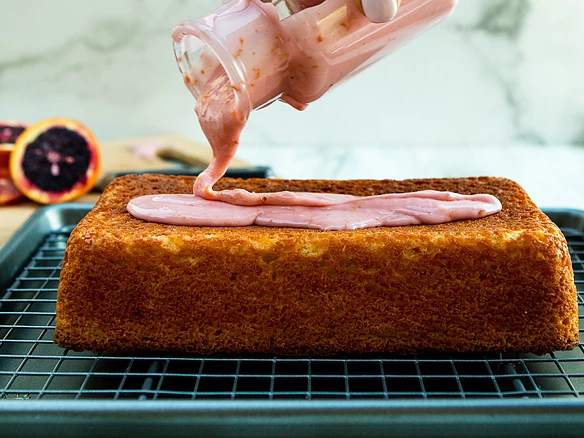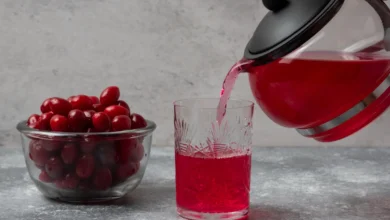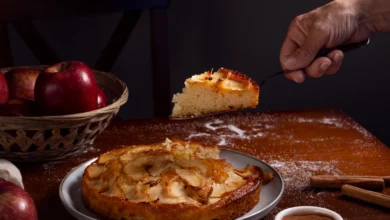The BEST Blood Orange Yogurt Cake Recipe: Easy & Delicious?

Let’s be honest, sometimes the best recipes aren’t the most complex. This blood orange cake is a shining example – easy, delicious, and just the right amount of special.
Contents
Blood Orange Yogurt Cake
Whether you’re craving a vibrant weekend treat, a simple citrus dessert with a touch of millennial pink, or even a slice of cake bread for breakfast, this recipe fits the bill. Let’s learn!
Finding Inspiration in Grandma’s Kitchen
I remember the first time my grandma surprised me with her killer blood orange cake. The color was so pretty – a deep blush with hints of pomegranate and beet. But the flavor is what really stuck with me: bright, sweet, and perfect for those long Christmas holidays. Seeing all the blood oranges in season got me nostalgic, so I figured, why not give grandma’s recipe a try?
Juice Adventures
Now, usually I’m a hand juicer kind of guy. You know, one of those classic wooden reamers Grandma would use. But there’s no shame in loving a good kitchen gadget, right? I was seriously tempted by a crazy heavy-duty citrus juicer. And honestly, since blood oranges are in season, I figured it was time to treat myself. Best. Decision. Ever. Seriously, if you make a lot of orange juice, lemon loaf cakes, or anything citrus, it might just become your favorite kitchen appliance. No more carpal tunnel!
You can even skip the juicer altogether if you’re feeling adventurous. Sometimes, the trash is the best place for the peels, and your hands are the best tools for squeezing every last drop of that gorgeous pink juice. It’s all about finding that balance, just like a good recipe.
It’s All About That Yogurt
One key ingredient that makes this blood orange cake special is the yogurt. It gives the cake a wonderful moistness and the perfect tangy counterpoint to all that sweetness. Whether you prefer lemon, plain, or even Greek yogurt, it works beautifully.
Taking it Further
This recipe provides a delightful base for your blood orange cake adventures! Want to elevate things? Here are a few ideas:
- Candied Blood Orange Slices: Talk about a showstopper – these candied slices look stunning on top, with hints of that pomegranate or strawberry sweetness!
- Blood Orange Coffee Cake: Imagine a swirl of cinnamon streusel and a generous drizzle of blood orange glaze. Now THAT’S a breakfast worth getting out of bed for.
- Salad Surprise: Try tossing some blood orange segments into a spinach salad with goat cheese, toasted pecans, and a citrus vinaigrette!
- Pound Cake Twist: Add an extra egg and some melted butter, and this recipe easily turns into a fantastic blood orange pound cake – perfect with a cup of tea! Or, for a hint of chocolate deliciousness, try folding in a handful of dark chocolate chips.
Are Blood Oranges, Oranges?
Yes, blood oranges are indeed a type of orange! They are a natural mutation of the sweet orange, with a distinctive crimson color that sets them apart. This unique color comes from naturally occurring pigments known as anthocyanins. You might recognize these pigments as the same ones that give purple cauliflower its vibrant hue. But, with blood oranges, the color isn’t always consistent. In some seasons, the crimson tones are more pronounced, and their flavor often has hints of raspberry alongside the usual citrus sweetness. It’s like getting lucky with the perfect mix of sweet and tart!
While blood oranges have a unique flavor, they’re versatile enough to stand-in for regular oranges in most recipes. You can use them for anything from freshly squeezed juice to a zesty salad dressing, or even a recipe like how sweet eats blood orange yogurt cake. Their flavor also makes them an excellent addition to recipes where you’d usually use lemon, like a classic French yogurt cake (Gâteau au Yaourt) with a blood orange twist!
A Charming History
The idea of a blood orange yogurt cake might feel modern, but the inspiration for this kind of recipe stretches back way further. Think “Gâteaux de Mamie”, or “Granny Cake” – a beloved staple in France. These simple, flavorful cakes are known for their ease and that special “granny” touch. What’s the secret ingredient, the special twist? Yogurt!
Forget precise measuring cups! In classic Granny Cake tradition, French yogurt pots are the key to measurement. Those cute little glass jars of set yogurt aren’t just charming, they become the perfect way to create a simple, delightful cake with just the right texture.
Nutritional Information
| Nutrient | Amount |
| Serving | 1 |
| Calories | 410.87kcal |
| Carbohydrates | 57.55g |
| Protein | 6.72g |
| Fat | 17.58g |
| Saturated Fat | 3.03g |
| Polyunsaturated Fat | 2.08g |
| Monounsaturated Fat | 11.84g |
| Trans Fat | 0.01g |
| Cholesterol | 63.66 mg |
| Sodium | 152.94 mg |
| Potassium | 119.38 mg |
| Fiber | 1.38g |
| Sugar | 34.94g |
| Vitamin A | 30.04IU |
| Vitamin C | 13.23 mg |
| Calcium | 108.41 mg |
| Iron | 0.86 mg |
Blood Orange Yogurt Cake Recipe
Course: DessertCuisine: French1
servings20
minutes1
hour410
kcal1
hour20
minutesThis simple yet vibrant Blood Orange Yogurt Cake is bursting with fresh citrus flavor and a wonderfully moist texture. Let’s make it!
Ingredients
1 1/2 cups all-purpose flour
2 teaspoons baking powder
1/4 teaspoon salt
1 cup plain Greek yogurt (full-fat or low-fat)
3/4 cup sugar
3 large eggs
Zest from 2 blood oranges
1/4 cup freshly squeezed blood orange juice
1 teaspoon vanilla extract
1/2 cup melted coconut oil
Directions
- Preheat & Prep: Start by preheating your oven to 350 degrees °F (175 °C). Thoroughly butter and flour a standard loaf pan to prevent sticking.
- Whisk Dry Ingredients: In a small bowl, whisk together flour, baking powder, and salt.
- Combine Wet Ingredients: In a large bowl, combine yogurt, sugar, eggs, orange zest, orange juice, and vanilla extract. Whisk until everything is well incorporated.
- Fold it Together: Gently add the dry ingredients to the wet ingredients. Use a spatula to fold the mixture, being careful not to overmix. If you’d like, substitute a bit of melted coconut oil for some butter – it adds a lovely subtle flavor! Once just combined, pour the batter into your greased loaf pan. Bake for 50–60 minutes, or until the center is set, and a toothpick inserted comes out clean. Allow the cake to cool in the pan for a bit before transferring it to a cooling rack to cool completely. Top with your favorite icing, slice, and serve!
Notes
- Customize it! Get creative with garnishes like candied blood orange slices, a dollop of whipped cream, or a sprinkle of toasted nuts.
- Yogurt Choice: Whole milk Greek yogurt will give the richest texture, but lower-fat varieties work too!
- Leftovers: This cake keeps well for a few days at room temperature. Cover loosely with plastic or keep it in an airtight container.
For Blood Orange Icing
Ingredients
- Zest from 1 blood orange
- 1 1/2 cups powdered sugar
- 2 tablespoons freshly squeezed blood orange juice
Instructions
Whisk together blood orange zest, powdered sugar, and juice in a large bowl until smooth. Once the cake is completely cooled, pour the icing generously over the top. Let it set for a bit before slicing and enjoying your masterpiece!
RELATED: Cookie Dough
RELATED: Hot Buttered Rum Apple Pie
Health Considerations
While this blood orange yogurt cake offers a healthier take on classic desserts, it’s important to be mindful of portion sizes, especially due to the sugar content. Blood oranges, like other citrus fruits, are a good source of Vitamin C and antioxidants, and the yogurt adds beneficial calcium and protein. Those with dairy sensitivities may want to seek out dairy-free yogurt alternatives. As with any treat, enjoy this vibrant and delicious cake in moderation as part of a balanced diet.
Note: Dairy-Free Alternative
This recipe’s yogurt base means it’s not dairy-free. Whisk and Nibble understands that some people need dairy-free options, and luckily, it’s easy to adapt this recipe! Simply substitute the Greek yogurt with your favorite plant-based yogurt (coconut, almond, or soy varieties all work well). You might also consider replacing the butter in the cake with a vegan alternative or using a neutral-flavored oil.
Conclusion
Whether you’re a fan of classic French baking, vibrant citrus flavors, or simply searching for a delicious and easy-to-make cake, this blood orange yogurt cake is sure to delight. The simplicity of the recipe makes it perfect for both experienced and novice bakers. So, the next time you spot those gorgeous blood oranges at the market, don’t hesitate to give this recipe a try – your tastebuds will thank you!
_____________________________
Frequently Asked Questions
What is the purpose of yogurt in cake?
Yogurt adds incredible tenderness and fluffiness to cakes. The slight acidity works wonders with the other ingredients, and the fat from the yogurt provides fantastic moisture, keeping your cake from drying out too quickly over a few days. Plus, it adds that sweet hint of tang that pairs so well with citrus flavors like blood orange.
What are the benefits of yogurt in baking?
The acidity in yogurt helps activate baking soda, leading to fluffier, lighter baked goods. Yogurt can also be a substitute for ingredients like sour cream, mayonnaise, or crème fraîche, adding a tangy flavor and healthy fats without the guilt. And let’s not forget – yogurt makes an impressive garnish (think yogurt parfaits), a healthier alternative to ice cream, or a base for light and creamy whipped cream toppings!
What is special about blood oranges?
Blood oranges get their signature color from pigments called anthocyanins. These same pigments have fantastic antioxidant properties! Research suggests they might help your body reduce damage from free radicals and even decrease your chance of certain cells becoming cancerous.
What does blood orange taste like?
The flavor of a blood orange is complex! They’re reminiscent of regular navel oranges but often boast unique floral notes. Generally, blood oranges are tart yet a bit sweeter and less acidic than regular oranges, sometimes even carrying hints of raspberry in their taste.
Which yogurt is better for baking?
Opt for full-fat, plain yogurt. It has a richer texture, whereas thinner yogurts tend to have more whey removed. Low-fat or nonfat yogurts work perfectly for things like salad dressings or marinades, but full-fat is best for baking.
What happens when yogurt is baked?
Some nutritional benefits of yogurt may change when cooked. Similar to when you heat raw milk, certain vitamins can be destroyed during the heating process. However, yogurt still provides moisture and other benefits, even after being baked. The good news? The active cultures are likely dead after cooking, but the tang and benefits of yogurt largely remain.
Is yogurt better than milk in cake?
Yogurt can often be a great replacement for milk in cake recipes, even substituting for things like sour cream! It adds a unique moistness, flavor, and tang. Most recipes allow for a one-to-one substitution. However, steer clear of flavored yogurts for baking, as the added sugar can throw things off.
Can I skip yogurt in baking?
If you need a substitute, milk can work, but you may want to reduce the amount by a few tablespoons because it’s thinner than yogurt. A good rule of thumb is using two tablespoons less milk than the recipe calls for in yogurt. If the batter seems too stiff, you can always add in a little more. Other options include buttermilk and sour cream for a similar tang and texture.




